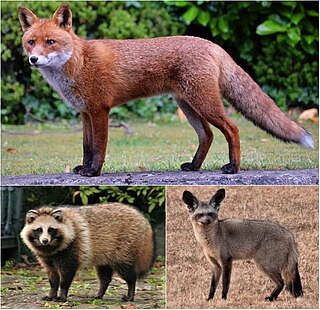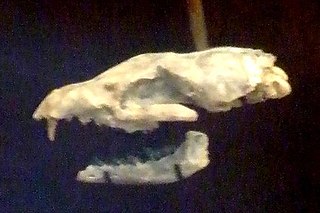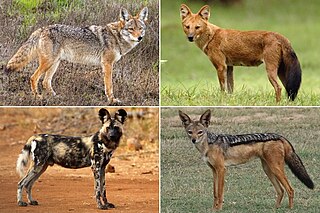
Canidae is a biological family of dog-like carnivorans, colloquially referred to as dogs, and constitutes a clade. A member of this family is also called a canid. There are three subfamilies found within the canid family, which are the extinct Borophaginae and Hesperocyoninae, and the extant Caninae. The Caninae are known as canines, and include domestic dogs, wolves, foxes, jackals and other extant and extinct species.

Dusicyon is an extinct genus of South American canids. The type species is Dusicyon australis, the Falkland Islands wolf. In 1914, Oldfield Thomas established this genus, in which he included the culpeo and other South American foxes. These other canids were removed to Lycalopex by Langguth in 1975. Dusicyon avus, widely distributed in the late Pleistocene from Uruguay through Buenos Aires Province to southernmost Chile, is the closest known relative of the Falkland Islands wolf; the two lineages split only about 16,000 years ago. It died out in the late Holocene, earlier estimates suggested about 2,980 years ago on the island of Tierra del Fuego and almost 1,700 years ago in the continent. More recent research confirms much later extinction dates, with the latest confirmed records in the Pampean Region being 700 BP and southernmost Patagonia at 400 years BP.

Canis is a genus of the Caninae which includes multiple extant species, such as wolves, dogs, coyotes, and golden jackals. Species of this genus are distinguished by their moderate to large size, their massive, well-developed skulls and dentition, long legs, and comparatively short ears and tails.

The South American foxes (Lycalopex), commonly called raposa in Portuguese, or zorro in Spanish, are a genus from South America of the subfamily Caninae. Despite their name, they are not true foxes, but are a unique canid genus more closely related to wolves and jackals than to true foxes; some of them resemble foxes due to convergent evolution. The South American gray fox, Lycalopex griseus, is the most common species, and is known for its large ears and a highly marketable, russet-fringed pelt.

The crab-eating fox, also known as the forest fox, wood fox, bushdog or maikong, is an extant species of medium-sized canid endemic to the central part of South America since at least the Pleistocene epoch. Like South American foxes, which are in the genus Lycalopex, it is not closely related to true foxes. Cerdocyon comes from the Greek words kerdo and kyon (dog) referring to the dog- and fox-like characteristics of this animal.

Vulpini is a taxonomic rank which represents the fox-like tribe of the subfamily Caninae, and is sister to the dog-like tribe Canini.

The Caninae, known as canines, are one of three subfamilies found within the canid family. The other two canid subfamilies are the extinct Borophaginae and Hesperocyoninae. The Caninae includes all living canids and their most recent fossil relatives. Their fossils were first found in North America and dated to the Oligocene era, then spreading to Asia at the end of the Miocene era, some 7 million to 8 million years ago.

The extinct Hesperocyoninae are one of three subfamilies found within the canid family. The other two canid subfamilies are the extinct Borophaginae and extant Caninae.

Archaeocyon is an extinct genus of the Borophaginae subfamily of canids native to North America. It lived during the Oligocene epoch 32-24 Ma., existing for approximately 8 million years. Species of Archaeocyon are among the earliest known borophagines, although a species of Otarocyon has a slightly earlier first appearance. Fossils have been found across the northern Great Plains and along the west coast of North America.

Xenocyon is an extinct subgenus of Canis. The group includes Canis (Xenocyon) africanus, Canis (Xenocyon) antonii and Canis (Xenocyon) falconeri that gave rise to Canis (Xenocyon) lycanoides. The hypercarnivorous Xenocyon gave rise to the modern dhole and the African wild dog.
Cynarctina is an extinct clade of the Borophaginae subfamily of canids native to North America. They lived from the Early to Middle Miocene 16.0—10.3 Ma, existing for approximately 5.7 million years. Cynarctines had rounded cusps on the molar teeth, similar to those seen in living bears, suggesting that they were likely omnivores.

Canis edwardii, also known as Edward's wolf, is an extinct species of wolf in the genus Canis which was endemic to North America three million years ago from the Late Blancan stage of the Pliocene epoch and was extinct by the end of the Irvingtonian stage of the Pleistocene epoch.

Canis cedazoensis is an extinct species of smaller canid which was endemic to North America during the Pleistocene epoch, 1.8 Ma—300,000 years ago.

Eucyon is an extinct genus of medium omnivorous coyote-like canid that first appeared in the Western United States during the late Middle Miocene 10 million years ago. It was the size of a jackal and weighed around 15kg. Its species E. zhoui was one of a number of North American mammals which invaded East Asia around 5–6 million years ago, followed by the genus going extinct 3 million years ago. This genus is proposed to have given rise to genus Canis 6 million years ago.
Canis nehringi is an extinct species of canid. Canis gezi, a poorly known small wolf from the Ensenadan of South America, appears to have given rise to Canis nehringi, a Lujanian species from Argentina. Betra's analysis in 1988, places Canis dirus and Canis nehringi as sister taxa and as the most derived members of the genus Canis in the New World. The species was first described by Florentino Ameghino in 1902.
Richard Hall Tedford was Curator Emeritus in the Department of Vertebrate Paleontology of the American Museum of Natural History in New York City, having been named as curator in 1969.
Dusicyon cultridens or Dusicyon patagonicus cultridens is an extinct canid species in the genus Dusicyon. However, the classification of this species is poorly researched and debatable. Some scientists place this species in the genera Canis and Lycalopex.

Canini is a taxonomic rank which represents the dog-like tribe of the subfamily Caninae, and is sister to the fox-like tribe Vulpini. The Canini came into existence 9 million years ago. This group was first represented by Eucyon, mostly by Eucyon davisi that was spread widely across North America and is basal to the other members of the tribe. Its members are informally known as true dogs.

Canina is a taxonomic rank which represents the wolf-like sub-tribe of the tribe Canini, and is sister to the sub-tribe Cerdocyonina. Fossils of this group date to 5 million years ago, however they are likely to have been in existence 9 million years ago. Its members as a group are colloquially known as the wolf-like canids.















